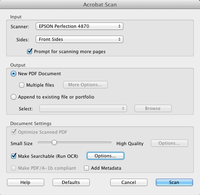Difference between revisions of "Create an Accessible PDF"
From Help Wiki
| Line 8: | Line 8: | ||
At Evergreen, we distribute a lot of instructional material in the form of PDFs (Portable Document Format). | At Evergreen, we distribute a lot of instructional material in the form of PDFs (Portable Document Format). | ||
| − | * | + | *When selecting or creating PDFs for use as course materials, make sure the document features OCR. |
*Optical Character Recognition is "the mechanical or electronic conversion of scanned images of handwritten, typewritten or printed text into machine-encoded text." | *Optical Character Recognition is "the mechanical or electronic conversion of scanned images of handwritten, typewritten or printed text into machine-encoded text." | ||
*OCR is a simple preset that must be selected within Acrobat Pro before starting your scans. Read about OCR and recommended scanning presets below. | *OCR is a simple preset that must be selected within Acrobat Pro before starting your scans. Read about OCR and recommended scanning presets below. | ||
| Line 34: | Line 34: | ||
*Navigate to File > Create PDF From Scanner. Select "Configure Presets." | *Navigate to File > Create PDF From Scanner. Select "Configure Presets." | ||
**On a Mac you are automatically prompted with the presets option screen below. | **On a Mac you are automatically prompted with the presets option screen below. | ||
| + | |||
[[File:OCR1.png|200px]] | [[File:OCR1.png|200px]] | ||
| Line 39: | Line 40: | ||
* Ensure that Optical Character Recognition is selected. | * Ensure that Optical Character Recognition is selected. | ||
**DPI must be 300 or higher to ensure the character recognition process is successful. | **DPI must be 300 or higher to ensure the character recognition process is successful. | ||
| + | |||
[[File:OCR2.png|200px]] | [[File:OCR2.png|200px]] | ||
| Line 45: | Line 47: | ||
**ClearScan OCR will keep the file size low while maintaining quality. | **ClearScan OCR will keep the file size low while maintaining quality. | ||
**Adobe has an excellent [http://blogs.adobe.com/acrolaw/2009/05/better_pdf_ocr_clearscan_is_smal/ writeup] about these options. | **Adobe has an excellent [http://blogs.adobe.com/acrolaw/2009/05/better_pdf_ocr_clearscan_is_smal/ writeup] about these options. | ||
| + | |||
| + | |||
| + | Need help? Contact the Academic Computing Help Desk at 360-867-6231 or create a help desk '''[http://help.evergreen.edu/ac support ticket]'''. | ||
Revision as of 14:04, 24 November 2014
It is important that PDFs being used for instruction feature Optical Character Recognition (OCR) so individuals with different learning abilities can access them.
At Evergreen, we distribute a lot of instructional material in the form of PDFs (Portable Document Format).
- When selecting or creating PDFs for use as course materials, make sure the document features OCR.
- Optical Character Recognition is "the mechanical or electronic conversion of scanned images of handwritten, typewritten or printed text into machine-encoded text."
- OCR is a simple preset that must be selected within Acrobat Pro before starting your scans. Read about OCR and recommended scanning presets below.
Using PDFs from Other Sources
There may not be a lot you can do if you are using a PDF from another source (such as journal articles or scanned photocopies) but there are a few elements you should look for when selecting PDFs to assign.
- Clear, readable text. Text may be inaccessible if it is warped, in an unusual font (such as Curlz or Handwriting), or is covered by handwriting/drawing. Students may be using software that uses OCR (Optical Character Recognition) in order to convert text to audio, if the characters aren't clear, the audio will be convoluted.
- Large font. Some individuals can read large type if there is a high contrast (e.g. black font against a white background or vice versa).
- Page numbers. Page numbers, particularly located at the top of pages, help students navigate where they are in the text.
- Straightforward structure. Many screen readers scan text from left to right, top to bottom. PDFs which include minimal break-out text boxes, tables, wrap-around text, etc., are generally accessible to students.
- Few images and alternative content. It goes without saying that students with visual impairments may not be able to access an image but this applies to other content as well: graphs, tables, diagrams, etc. Captions and descriptions for visual-based content can provide students with information they might have missed otherwise.
How to Make Accessible PDF Docs
Please note: This process assumes that you are using Adobe Acrobat Pro, version 9 or higher, on either a Windows or Macintosh computer.
Scanning Process
- Turn on scanner
- Place first page on scanner bed, aligned according to size and scanner layout
- Start Adobe Acrobat Pro from the Start Menu or Launcher
- Navigate to File > Create PDF From Scanner. Select "Configure Presets."
- On a Mac you are automatically prompted with the presets option screen below.
- Ensure that Optical Character Recognition is selected.
- DPI must be 300 or higher to ensure the character recognition process is successful.
- If you select the "options" button next to the OCR checkbox, you are able to change the OCR type from "ImageScan" to "ClearScan."
- ClearScan OCR will keep the file size low while maintaining quality.
- Adobe has an excellent writeup about these options.
Need help? Contact the Academic Computing Help Desk at 360-867-6231 or create a help desk support ticket.


